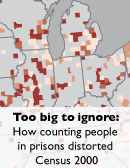
Too big to ignore:
How counting people in prisons distorted Census 2000
By Rose Heyer and Peter Wagner
Prison Policy Initiative
April 2004
Section:
Impact on income statistics
The Census Bureau’s enumeration of prisoners as residents of the prison towns complicates research and frustrates efforts at the state level to shift resources appropriately. Prisoners are included in per-capita income statistics. How large of an impact this has on the perception of the relative poverty of communities and on ensuing government policy has not yet been fully explored.
It would appear that urban areas that have a high incarceration rate would artificially have their per-capita income figures raised by not being able to count the prisoners as residents. Prison hosting areas would, by the per-capita income measure, look poorer as a result of the inclusion of the prisoners as local residents. This issue may be the most complicated for data users to correct, as it requires an understanding of how much income, if any, prisoners earn in a year.
Rural communities that host prisons are often quite impoverished in their own right. However, the authors are not aware of any study of rural economic development in which the researchers corrected for the impact of prisoners on per capita income before conducting their analysis.
For example, rural prison-hosting Cumberland County, New Jersey is an impoverished county on par with the urban counties that contain Newark and Trenton. Cumberland County ranks 3rd in New Jersey for counties with large portions of their households making under $10,000 a year. Cumberland County is the only New Jersey county where the median household income in 1999 was below $40,000, and it has the lowest per-capita income in the state at $17,376.[14] Prisoners and other group quarters populations are excluded from household income statistics, but are included in per-capita income. If we assumed that prisoners have no income and we deduct them from the calculations, the per-capita income for Cumberland County would rise a significant $897.
More research needs to be done as to the impact of prisoners on per-capita income. What do prisoners in various states report as their income? In states where Census forms are completed administratively, how is this data calculated? Our own informal research suggests that prison wages are inadequate for subsistence and that many prisoners rely on gifts from family members. Are these funds counted as income, and most importantly, should they be? And while these answers would allow a sophisticated data user to more accurately interpret Census income data in prison hosting communities, the urban policy analyst would still be unable to know where incarcerated people should have been counted and what their impact would be on income statistics in particular neighborhoods.
Footnotes
[14] Peter Wagner, Miscounting prisoners complicates Census portrait of New Jersey, PrisonersoftheCensus.org Fact of the Week for March 22, 2004.



